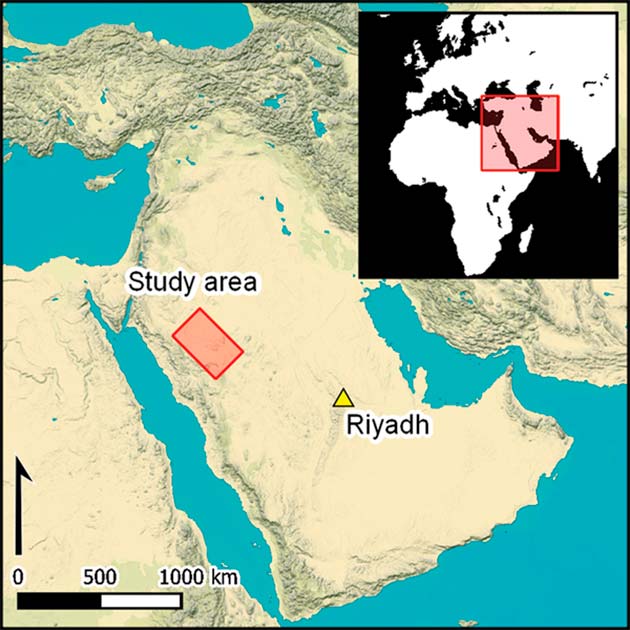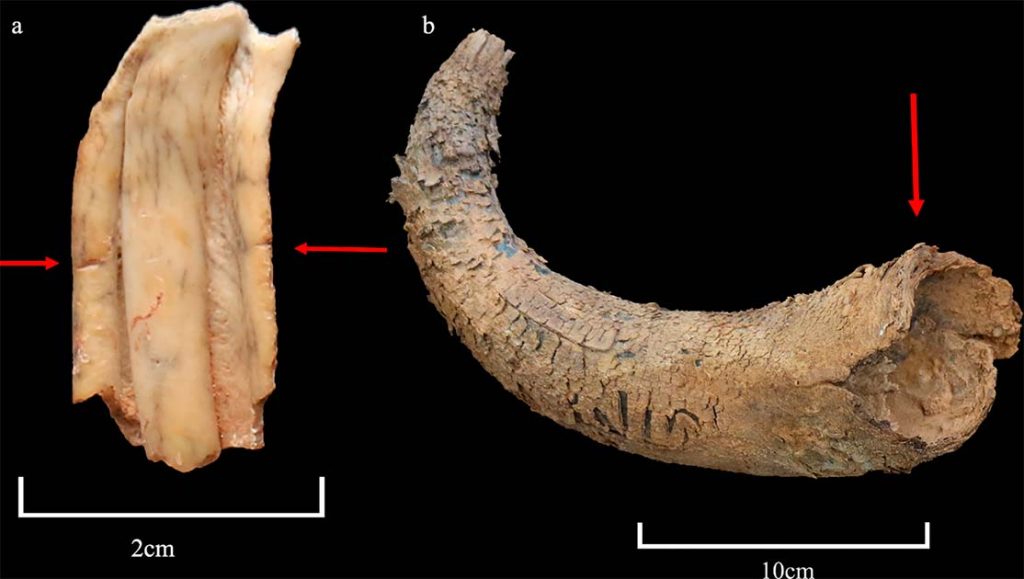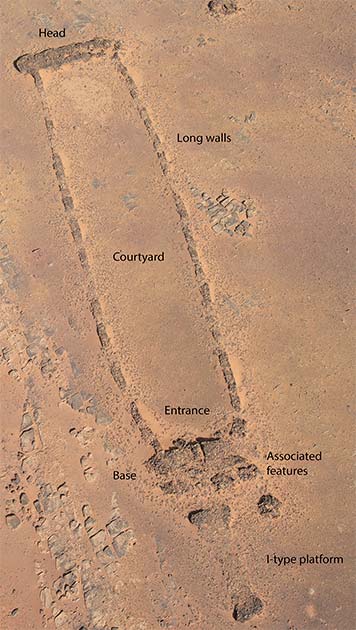The Mustatil or mustatils are giant prehistoric monuments found in Northwest Saudi Arabia made from sandstone. They have been named as such due to their shape: “mustatil” in Arabic translates to “rectangle”. This should give you an idea as to the mystery that surrounds them.
Characteristically, they have a long central courtyard with walls surrounding it. At one end, there is a rubble platform whilst at the other are some entrances, though some of these are deliberately closed off by stones.
And there are an immense number of them. In one area alone, there are over 1,000 mustatils, often clustered in groups ranging between 2 to 19. They have in total been built across a landscape of around 200,000 square kilometers (77,000 square miles).
They also vary considerably. In length, they range from 20 to 600 meters (65 to 2,000 feet). The walls are made from stones reaching a height of around 1.2 meters (4 feet) and some of these stones weigh 500 kilograms (1,100 lb). A huge engineering feat. But where did they come from and who built them?
Discovery
The mustatils first came to be studied in the 1970s when researchers spotted their pattern. An early excavation of one was funded by the Royal Commission for Al-‘Ula and revealed a central chamber containing fragments of cattle skulls.
Interestingly there were no other remains of other animals found there. Hence this area is thought to have been used by a previously unheard-of cattle cult, or perhaps pressed into more practical use by an agricultural people.
However, it was not until 2017 that these structures have begun to be studied systematically. Originally, they were called “gates” due to their resemblance to European gate structures, but it was soon changed to mustatil.

Because there are so many of them and they are concentrated in one area, it has been concluded that these rectangular structures must have held quite an important role in ancient Arabian culture and the landscape. They were built in great numbers and with the size apparently being almost irrelevant.
- What is Rujm el-Hiri? Puzzling Labyrinth of the Golan Heights
- Who Built the Bakoni Ruins of South Africa, and When?
In 2018 and 2019, there was some direct fieldwork put in place to photograph these areas. Over 4 seasons, over 350 mustatils have been photographed and 641 have been identified through a mixture of aerial photography and remote sensing. In addition to this, 39 of the mustatils have been surveyed with some being excavated recently revealing new features and characteristics about them.
What Makes a Mustatil?
Mustatils have been characterized by key features. From an entryway one passes into a large courtyard with long walls on either side. In most cases circular cells are also attached to the structures.
The “head” of the rectangle is also a common feature, usually a rectangular shape made of dry-stone masonry at one end of the rectangle. In the center of the head is usually a chamber of around 2.8m (9 feet) with multiple doorways, though some of these have been deliberately blocked through piling up stones or simply placing one single capping stone.

The rectangular courtyard seems to have been designed to be empty. There has been no evidence to suggest that there was anything built into them. However, this has been obscured by the fact that later enclosures were built in this area.
The walls of the courtyard were made mostly of two rows of stones laid in a mixture of horizontal and vertical placement. This combined with a rubble platform base and some show evidence of considerable engineering skill in their construction.
The significant aspect of the rubble platform base was that it had a narrow entrance. These have been seen in most mustatils, positioned in the center of the base platform and directly opposite the central chamber found at the head of the structure. Again, some of these were blocked up but research has suggested that this was symbolic. Only a few stones were placed there.
Other designs exist as well. Clusters of keyhole-shaped enclosures have been found, with a narrowing courtyard which leads to a circular area at its peak. Why these are different from the other designs, and whether they served the same purpose, remains uncertain.
The mustatils were built mostly upon the bedrock of the area. Interestingly, the structures were built without a preferential orientation. They do not seem to point toward local landmarks or match up with any cardinal points.
Instead, they seem to be dictated by the landscape which varies quickly in this area. If a mustatil was built upon a hill, then they usually were orientated so that it went perpendicular to the slope. However, if they were built in narrow areas, they extended for much longer to try and make the most of the longest available edge.
The mustatil heads were usually built higher than the rest of the structure. However, this is hard to discern in all areas as some of them are particularly flat or on a plateau. When they were built on a hillside, it has been suggested that it was intentional so that they could be seen from a distance.
Additionally, when they were built on flatter areas, the view from the head gives a prominent view. This suggests that being able to get a better view of an area played a part in where these structures were built.
What Were they For?
So, highly visible enclosures with apparently symbolic structures arranged within, built in great numbers across an enormous area. These were clearly important, but the reason for this importance is elusive given the mystery of their function.
In 2019, excavations of a previously undisturbed mustatil began. In these excavations, the archaeologists found animal remains such as skulls and horns. These were mostly made up of agricultural animals such as cattle, sheep, and gazelle, though cattle made up the majority of the finds.

It has been interpreted that these remains were offerings to a deity as they were placed near a large upright stone. Were these temples of some unknown religion? If so, it was only animals who were killed here: no human remains have been found as of yet.
It has been speculated that there was a ritualistic element to these structures and that it is likely a procession would have taken place along the long corridors of the rectangle. However, their closeness to each other presents some difficulty.
We don’t even know how old they truly are. Radiocarbon dating from the animals show some of them to be almost 6,000 years old. However, it is impossible to know if these animals pre-or post-date the structure: the mustatils could be much, much older.
Thanks to the funerary activity that happened later on however a date can be suggested. Due to the fact that these funerary structures were built on top of the mustatils, anything found there must post-date the structures.
Based on the grave goods found in these areas, which came back dated to around 4000-3000 BC, it has been concluded that the structures of the mustatils can be dated before this. It is possible that the date of 6000 BC is accurate. This puts these structures well on par with the dating of Stonehenge, and the mustatils may be even older. Though it is hard to know for sure just now.
Top Image: The mustatils are associated with an ancient cattle cult, and the bones of sacrificed animals have been found in the structures. Source: Thomas, H., Kennedy, M., Dalton, M., McMahon, J., Boyer, D., & Repper, R. / CC BY 4.0.
By Kurt Readman